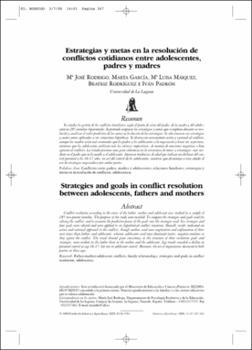Estrategias y metas en la resolución de conflictos cotidianos entre adolescentes, padres y madres
Fecha
2008Resumen
Se estudia la gestión de los conflictos familiares según el punto de vista del padre, de la madre y del adolescente en 295 familias biparentales. Se pretende comparar las estrategias y metas que se emplean durante su resolución y analizar el valor predictivo de las metas en la elección de las estrategias. Se seleccionaron seis estrategias
y cuatro metas aplicadas a seis situaciones hipotéticas. Se observa un acercamiento activo y racional al conflicto,
aunque las madres están más orientadas que los padres y los adolescentes a la negociación y hacer ver su postura,
mientras que los adolescentes utilizan más las tácticas impositivas, de manejo de emociones negativas o bien
ignoran el conflicto. La tríada presenta una gran coherencia en la estructura de metas y estrategias, más evidente en el padre que en la madre y el adolescente. Aparecen tendencias de edad que indican un declinar del control parental a los 16-17 años, no así del control de los adolescentes, mientras que disminuye a estas edades el
uso de estrategias negociadoras por ambas partes. Conflict resolution according to the views of the father, mother and adolescent was studied in a sample of 295 two-parent families. The purposes of the study were twofold: To compare the strategies and goals used for solving the conflict, and to examine the predictive power of the goals over the strategies used. Six strategies and four goals were selected and were applied to six hypothetical conflict situations. Overall, results indicated an
active and rational approach to the conflicts, though mothers used more negotiation and explanation of their own views than fathers and adolescents, whereas adolescents used more dominant tactics, negative emotions or they ignore the conflict. The triad showed great consistency in the structure of their resolution goals and strategies, more evident in the father than in the mother and the adolescent. Age trends revealed a decline in parental control at age 16-17, but not in adolescent control. Moreover, the use of negotiations decreased in both parties at those ages.





